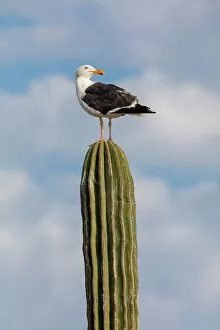Larus Livens Collection
The Yellow-footed gull (Larus livens) is a stunning bird species that can be found in the Gulf of California, also known as the Sea of Cortez, Mexico
For sale as Licensed Images
Choose your image, Select your licence and Download the media
The Yellow-footed gull (Larus livens) is a stunning bird species that can be found in the Gulf of California, also known as the Sea of Cortez, Mexico. With its vibrant yellow feet and sleek white feathers, it stands out against the backdrop of El Pardito Island and the Islands of Gulf of California Protected Area. One captivating image shows a Yellow-footed gull perched gracefully on a Mexican giant cardon cactus. This unique sight showcases the bird's ability to adapt to its surroundings and find solace even in prickly situations. Another photo captures an intense moment as Yellow-footed gulls engage in a fierce battle with Heermanns gulls for territory or food. These birds are not afraid to assert themselves and fight for their survival amidst the vastness of their habitat. In yet another striking shot, an adult osprey proudly holds onto its catch while sharing its space with a Yellow-footed gull. This harmonious coexistence between two different avian species highlights the diversity and richness of life within this region. Photographer Michael S. Nolan has beautifully captured multiple images showcasing these magnificent creatures in their natural habitat. Each photograph tells a story, evoking emotions ranging from awe to admiration for these resilient birds, and is fascinating to learn that the Yellow-footed Gull is endemic only to the Gulf of California, making it even more special and deserving of protection. One picture depicts an adult Yellow-footed Gull feasting on a clam found during low tide on exposed tidal flats—an example of how they have adapted their feeding habits according to their environment. These images serve as reminders that we must appreciate and conserve such unique wildlife treasures like Larus livens in order to preserve our planet's biodiversity for future generations.




